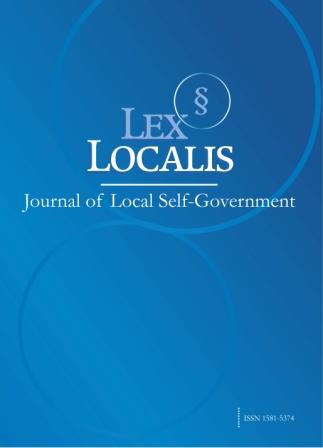Akterji v inovacijskih procesih in sodelovanju – študija primera osmih finskih občin
DOI:
https://doi.org/10.4335/17.2.247-266(2019)Ključne besede:
sodelovanje na področju inovacij, študija primera, inovacijski procesi, razvojni procesi, FinskaPovzetek
Ta študija proučuje vloge različnih akterjev v inovacijskih procesih. Teoretični okvir, na katerem temelji ta študija, se ukvarja predvsem z idejo sodelovanja na področju inovacij. To je študija primera osmih finskih občin (Hattula, Hollola, Hämeenlinna, Kuusamo, Pudasjärvi, Raahe, Rovaniemi in Salo) in njihovih inovacijskih procesov. Raziskovalno vprašanje je: kako je prišlo do sodelovanja med različnimi akterji v opazovanih razvojnih procesih? Glavni podatki tega članka izhajajo iz delavnic, izvedenih v teh osmih občinah. Štiri skupine akterjev izhajajo iz empirične analize: ključni akterji, akterji znotraj občinske organizacije, akterji znotraj občine in akterji zunaj občine. Izpostavljene so vloge pospeševalcev, koordinatorjev in vodij inovacijskih procesov in upravljanja občin. Ti ključni akterji imajo možnost pospeševanja in organiziranja sodelovanja v inovacijskih procesih. Prakse sodelovanja v inovacijskih procesih so obravnavane kot pomemben cilj in pomen vključevanja različnih deležnikov je kar široko razumljen. Kljub temu pa izgleda, da je sistematični pristop k sodelovanju v teh procesih pomanjkljiv in v določenih primerih so lahko pomanjkljivi tudi instrumenti za sodelovanje.
Literatura
Argyris, C. (2010) Organizational traps. Leadership, culture, organizational design (Oxford: Oxford University Press).
Bogers, M. (2011) Knowledge sharing in open innovation: The overview of theoretical perspectives on collaborative innovation, de Pablos Heredero, C. (ed.) Open Innovation in Firms and Public Administrations: Technologies for Value Creation: Technologies for Value Creation (Hershey, PA: IGI Global).
Bogers, M., Zobel, A. K., Afuah, A., Almirall, E., Brunswicker, S., Dahlander, L., Frederiksen, L., Gawer, A., Gruber M., Haefliger S., Hagedoorn J., Hilgers D., Laursen, K., Magnusson, M. G, Majchrzak, A., McCarthy, I. P., Moeslein, K. M., Nambisan, S., Piller, F. T., Radziwon, A. Rossi-Lamastra, C., Sims, J. & Ter Wal, A. L. J. (2017) The open innovation research landscape: Established perspectives and emerging themes across different levels of analysis, Industry and Innovation, 24(1), pp. 8–40, https://doi.org/10.1080/13662716.2016.1240068.
Bogers, M., Afuah, A. & Bastian, B. (2010). Users as innovators: a review, critique, and future research directions, Journal of Management, 36(4), pp. 857–875, https://doi.org/10.1177/0149206309353944.
Bourgon, J. (2017) The new synthesis of public administration. Fieldbook (Copenhagen:Dansk Psykologisk Forlag A/S).
Bovard, T. (2007) Beyond engagement and participation – user and community co-production of public services, Public Administration Review, 67(5), pp. 846–860, https://doi.org/10.1111/j.1540-6210.2007.00773.x.
Bommert, B. (2010) Collaborative innovation in the public sector, International public management review, 11(1), pp. 15–33.
Borins, S. (2002) Leadership and innovation in the public sector, Leadership & Organization Development Journal, 23(8), pp. 467–476, https://doi.org/10.1108/01437730210449357.
Cook, T. E. & Morgan, P. M. (1971) Participatory democracy (San Francisco: Canfield Press).
Chesbrough, H. W. (2006) Open innovation: The new imperative for creating and profiting from technology (Boston Massachusetts: Harvard Business Press).
Damanpour, F. (1991) Organizational innovation: A meta-analysis of effects of determinants and moderators, Academy of management journal, 34(3), pp. 555–590.
Damanpour, F., & Aravind, D. (2012) Managerial innovation: Conceptions, processes, and antecedents, Management and Organization Review, 8(2), pp. 423–454, https://doi.org/10.5465/256406.
Eggers, W. D. & Singh, S. K. (2009) The Public Innovator's Playbook: Nurturing bold ideas in government (Ash Institute, Harvard Kennedy School).
Flyvbjerg, B. (2006) Five misunderstandings about case-study research, Qualitative inquiry, 12(2), pp. 219–245, https://doi.org/10.1177/1077800405284363.
Greve, C. (2015) Ideas in public management reform for the 2010s: Digitalization, value creation and involvement, Public Organization Review, 15(1), pp. 49–65.
Hartley, J. (2005) Innovation in governance and public services: Past and present, Public money and management, 25(1), pp. 27-34, https://doi.org/10.1111/j.1467-9302.2005.00447.x.
Hartley, J., Sørensen, E. & Torfing, J. (2013) Collaborative innovation: A viable alternative to market competition and organizational entrepreneurship, Public Administration Review, 73(6), pp. 821–830, https://doi.org/10.1111/puar.12136.
Haveri, A. (2006) Complexity in local government change, Public Management Review, 8(1), pp. 31–46, https://doi.org/10.1080/14719030500518667.
Kallio, K. P., Häkli, J. & Bäcklund, P. (2015) Lived citizenship as the locus of political agency in participatory policy, Citizenship studies, 19(1), pp. 101–119, http://urn.fi/URN:NBN:fi:uta-201412182457.
Lee, S. M., Hwang, T. & Choi, D. (2012) Open innovation in the public sector of leading countries, Management Decision, 50(1), pp. 147–162, https://doi.org/10.1108/00251741211194921.
Michels, A. & De Graaf, L. (2010).Examining Citizen Participation: Local Participatory Policy Making and Democracy, Local Government Studies, 36(4), pp. 477–491, https://doi.org/10.1080/03003930.2010.494101.
Nambisan, S. (2008) Transforming government through collaborative innovation (Washington, DC: IBM Center for the Business of Government).
Osborne, S. (2010) The (new) public governance: A suitable case for treatment?, In: Osborne, S. (ed.) The new public governance? Emerging perspectives on the theory and practice of public governance (Abingdon, Oxon: Routledge), pp. 1–16.
Prahalad, C. K. & Ramaswamy, V. (2004) Co‐creation experiences: The next practice in value creation, Journal of interactive marketing, 18(3), pp. 5–14. https://doi.org/10.1002/dir.20015.
Sørensen, E. & Torfing, J. (2011) Enhancing collaborative innovation in the public sector, Administration & Society, 43(8), pp. 842–868, https://doi.org/10.1177/0095399711418768.
Sørensen, E. & Torfing, J. (2017) Metagoverning collaborative innovation in governance networks, The American Review of Public Administration, 47(7), pp. 826-839, https://doi.org/10.1177/0275074016643181.
Spohrer, J., & Freund L. E. (eds.) (2013) Advances in the human side of service engineering (Boca Raton: Taylor & Francis Group).
The Association of Finnish Local and Regional Authorities (2018) Finnish municipalities and regions (Helsinki: The Association of Finnish Local and Regional Authorities), available at: https://www.localfinland.fi/expert-services/finnish-municipalities-and-regions (August 16, 2018).
Tuurnas, S. (2015) Learning to co-produce? The perspective of public service professionals, International Journal of Public Sector Management, 28(7), pp. 583–598, https://doi.org/10.1108/IJPSM-04-2015-0073.
Tuurnas, S. (2016) The Professional Side of Co-Production. Acta Universitatis Tamperensis 2163 (Tampere: Tampere University Press).
Waldorff, S. B., Kristensen, L. S. & Ebbesen, B. V. (2014) The complexity of governance: challenges for public sector innovation, In: Ansell, C. & Torfing, J. (eds.) Public Innovation Through Collaboration and Design (London: Routledge), pp. 70–88.
Vargo, S. L.,& Lusch, R. F. (2015) Institutions and axioms: an extension and update of service-dominant logic, Journal of the Academy of Marketing Science, 44(1), pp. 5–23, https://doi.org/10.1007/s11747-015-0456-3.
Vargo, S. L., Wieland, H. & Akaka, M. (2016) Innovation in service ecosystems, Journal of Serviceology, 1(1), pp. 1–5, https://doi.org/10.1108/JOSM-02-2015-0044.
Yin, R. K. (2014) Case study research: design and methods (Los Angeles, London, New Delhi, Singapore & Washington DC: Sage Publications).








